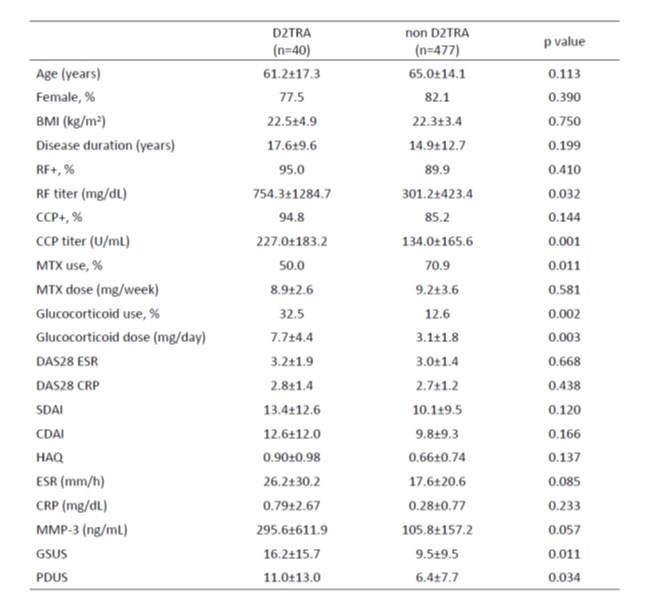Session Information
Session Type: Poster Session B
Session Time: 9:00AM-11:00AM
Background/Purpose: In recent years, the concept of D2T RA (difficult-to-treat rheumatoid arthritis) has become widespread, and D2T RA patients are defined as a state in which activity cannot be controlled even with the use of various molecular-targeted drugs. In this study, we investigated the ultrasound synovial findings in D2T RA patients. However, ultrasound findings in D2T RA patients are unknown. In this study, we investigated the ultrasound findings of D2T RA patients.
Methods: A total of 750 RA patients who underwent ultrasound examination from January 2017 to August 2020 were continuously included. Ultrasound examination was performed at the of bilateral first to fifth metacarpophalangeal (MCP) joints, first interphalangeal (IP) and second to fifth proximal interphalangeal (PIP) joints, wrist joints (three part of radial, medial and ulnar) and first to fifth metatarsophalangeal (MTP) joints. Both grayscale (GS) and power Doppler (PD) findings were scored to grade 0-3 by a semi-quantitative method, and the sum of GS was defined as the GSUS score and the sum of PD as the PDUS score. Of all 750 RA patients, 517 RA patients (68.9%) who treated bDMARDs/JAKi were included and devided in D2T RA patients and non-D2T RA patients. The patients’ characteristics, GSUS and PDUS score were compared between D2T RA patients and non-D2T RA patients.
Results: There were 40 D2T RA patients and 477 non-D2T RA patients. Mean age was 61.2 vs. 65.0 years (p=0.133), mean disease duration of RA was 17.6 vs. 14.9 years (p=0.199), CDAI was 12.6 vs. 9.8 (0.166), and CRP level was 0.79 vs. 0.28 mg/dL (p=0.233), MMP-3 level was 295.6 vs 10.8ng/mL (p=0.057), respectively. In the D2T RA group, concomitant use ratio of MTX was low (50.0 vs 70.9 %, p=0.011), but there was no difference in the average dose of MTX (8.9 vs 9.2 mg/w, p=0.581). The concomitant use ratio of glucocorticoid (32.5 vs 12.6 %, p=0.002) and the average dose of glucocorticoid (7.7 vs 3.1 mg/d, p=0.003) were higher in D2T RA group. Regarding ultrasound findings, GSUS score (16.2 vs 9.5, p=0.011) and PDUS score (11.0 vs 6.4, p=0.034) were significantly higher in the D2T RA group.
Conclusion: The definition of D2T RA is resistant to multiple mode of bDMARDs/JAKi. Although, disease activity and inflammatory markers tended to be worse in the D2T RA group, there was no statistically significant difference in this study. However, ultrasound findings were significantly worse in D2T RA. Suppression of synovitis might be important to prevent D2T RA.
To cite this abstract in AMA style:
Okano T, Mamoto K, Yamada Y, Anno S, Yagami A, Domae Y, Washida S, Yoshida Y, Koike T, Nakamura H. Ultrasound Findings in Patients with Difficult to Treat Rheumatoid Arthritis [abstract]. Arthritis Rheumatol. 2023; 75 (suppl 9). https://acrabstracts.org/abstract/ultrasound-findings-in-patients-with-difficult-to-treat-rheumatoid-arthritis/. Accessed .« Back to ACR Convergence 2023
ACR Meeting Abstracts - https://acrabstracts.org/abstract/ultrasound-findings-in-patients-with-difficult-to-treat-rheumatoid-arthritis/

